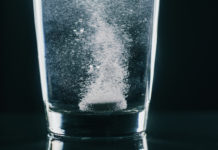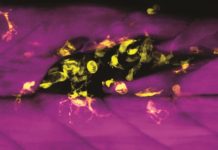Clinical Trial of Age-Related Health Problems in 150 Adults
by Jim English
Vital Cell® is an advanced herbal formula designed to counter a host of problems commonly associated with human aging. By supporting healthy microcirculation Vital Cell has been shown to enhance energy levels, reduce plasma viscosity, enhance microcirculation and reverse capillary damage. Additionally, by promoting improved internal organ function and speeding removal of cellular waste products such as lipofuscin, Vital Cell can support the immune system to increase resistance to illness and improve overall health (see Restoring Thymus Function for Enhanced Immune Support).
The following article is a shortened summary condensed from a large clinical trial of Vital Cell involving 150 patients, aged 55 to 89 years old. In their paper the study researchers documented significant improvements in a wide range of symptoms commonly associated with age-related degenerative health issues.
Coughing, Shortness of Breath
Human aging is associated with the partial or complete wasting (atrophy) of the adrenal cortex and sex glands, resulting in deterioration of the mononuclear phagocyte system (part of the immune system) and a decline in antibody production for protection from infection. Other factors, such as a narrowing or obstruction of the pulmonary arteries, contribute to inflammation of the bronchial walls, resulting in lung congestion, edema, fibroplastic proliferation and narrowing of the bronchial tubes. Symptoms often include chronic coughing and shortness of breath.
Coughing: Before receiving Vital Cell, patients were questioned about their coughing patterns. Coughing fits lasting five minutes or longer, and occurring in both the morning and evening, were considered diagnostically relevant. Thirty-six patients reported that they experienced bouts of coughing lasting longer than five minutes in both morning and evening. After taking Vital Cell for one month, 34 patients reported improvement (94 percent), and only two cases reported coughing fits still lasting for more than five minutes.
Shortness of Breath: To determine shortness of breath, all 150 patients were required to climb one flight of stairs, after which their breathing was monitored and recorded. These records were compared to records gathered at intake. At the start of the study, 42 patients experienced shortness of breath during the stair test. At the conclusion of the study only seven patients still experienced shortness of breath, while 35 patients (83 percent) were able to complete the stair test without difficulty.
Dizziness
Dizziness is one of the most common complaints of the elderly. Originating in the central vestibule of the brain stem, age-related dizziness is often related to impaired blood flow caused by hardening of the arteries. Prior to the trial, 69 patients reported experiencing bouts of dizziness. After one month of treatment, 59 patients (85 percent) reported that their symptoms had abated, while only 10 patients (15 percent) still experienced episodes of dizziness.
Edema, Puffiness of Lower Limbs
In the elderly, as plasma albumin levels decrease, colloid osmotic pressure of the plasma is reduced as well. Additionally, as aging blood vessels become increasingly permeable, plasma levels of sex hormones decline, leading to increased retention of water and sodium. Together these changes contribute to increased accumulation of fluid (edema) and swelling in the lower limbs. Vital Cell has previously been shown to increase plasma albumin and sex hormone levels, leading researchers to theorize that the formula would aid in reducing lower limb edema. Prior to administration of Vital Cell, 32 subjects were diagnosed with edema of the lower limbs, including edema resulting from chronic heart failure and chronic renal dysfunction. After one month of treatment with Vital Cell, 30 patients (94 percent) were free of edema, and only two patients still showed signs of swelling of the lower limbs.
Loss of Appetite
The gradual decline of the hypothalamuspituitary- adrenal cortex is a hallmark of human aging. As the thyroid glands deteriorate, secretion of digestive enzymes and gastric juices are reduced, resulting in a loss of appetite. Before receiving Vital Cell, 56 patients suffered from diminished appetite. At the conclusion of the study, 49 patients (87 percent) reported that their appetite had returned, and only seven patients continued to show signs of poor appetite after treatment.
Blood Pressure
In the elderly, elevated systolic and diastolic blood pressure levels result from the loss of elasticity in the arterial walls. Other contributing factors include narrowing of the diameter of blood vessels, increased resistance to peripheral blood flow, and elevated blood serum viscosity. Vital Cell has been shown to exert positive anti-aging effects to aid in normalizing blood pressure levels.
Researchers measured blood pressure levels of patients before and after treatment with Vital Cell. Of the 150 volunteers, only those with a systolic pressure greater than 160 and a diastolic pressure greater than 90 were selected for further evaluation, for a total of 62 subjects. Before administration, 26 patients had blood pressure measurements greater than 160/90. The highest systolic pressure was 207, and the highest diastolic pressure was 120. The average systolic pressure was 149, and the average diastolic pressure was 89.
After taking Vital Cell for 30 days, blood pressure readings greater than 160/90 were seen in only three subjects. The highest systolic pressure of those who were treated was 150, while the average dropped to 127. The highest diastolic pressure fell to 100, while the average fell to 79.
Improved ECG
Of the 150 study patients admitted to the study, 48 had been previously diagnosed with coronary heart disease. Prior to receiving Vital Cell, ECG abnormalities were detected in 35 patients, including STT changes, frequent premature atrial beat, atrial fibrillation and frequent premature ventricular beat. Following treatment 30 patients (85 percent) were shown to be free of the previously detected ECG abnormalities, while five patients (15 percent) were found to still have abnormal ECGs.
Blood Flow
Researchers randomly gathered blood samples from 41 patients (20 males and 21 females) prior to treatment and at the end of the study. The examiners conducted the following tests on blood samples:
- Whole-blood specific viscosity
- Erythrocyte sedimentation rate
- Hematocrit (red blood cell count)
- Plasma specific viscosity
- Erythrocyte electrophoresis
While there were no detectible changes in erythrocyte sedimentation rate or hematocrit after treatment, test results revealed significant improvements in whole-blood specific viscosity, plasma specific viscosity and erythrocyte electrophoresis.
Microcirculation
Researchers randomly selected 51 patients to measure circulation in nail-fold microcapillaries prior to receiving Vital Cell, and again at the end of the study. Microscopic observations revealed significant improvements in the speed of blood flowing through the microcapillaries of the nail folds after treatment.
Immune Function
To evaluate Vital Cell’s impact on immune function, the researchers selected 44 patients for blood tests. Efficiency of cellular immunity was determined by measuring lymphocyte transformation rate, and the immune function of red blood cells was determined by erythrocyte rosette (Erosette) formation.
Lymphocyte Transformation Rate: The average value before administration of Vital Cell was 53.944. This value rose to 59.444 after one month of treatment. This was a considerable increase showing statistical significance (P<0.05).
Test of Rosette Formation: Average value prior to administration of Vital Cell was 52.176. This value increased greatly to 54.647 after treatment. The difference was statistically significant. (P<0.05).
Metabolism of Plasma Proteins
Albumin is an abundant blood plasma protein produced by the liver and secreted into the blood. In addition to preventing the leakage of fluids from the capillaries into surrounding tissues, albumin aids in transporting small molecules, such as calcium, unconjugated bilirubin, free fatty acids, cortisol and thyroxine. Serum albumin levels can serve as a useful marker of chronic liver disease and nutritional status. Researchers measured albumin levels in 44 patients prior to administration with Vital Cell and again at the end of treatment.
Plasma Albumin: The average value of plasma albumin was 4.573 before Vital Cell, and rose to 4.768 by the end of the study. These numbers were statistically significant (P<0.01).
Plasma Globulin: Prior to administration, average plasma globulin was 2.734. This number decreased to 2.564, indicating a statistically significant improvement.
Plasma Albumin/Globulin Ratio: The ratio before treatment was 1.702, and increased to 1.897 following the treatment period. The difference indicated a great statistical significance (P<0.01).
Summary
Vital Cell has been shown to have excellent therapeutic actions on such elderly disorders as chest tightness, insomnia, chest pains, coughing, shortness of breath, heart palpitations, dizziness and lack of appetite. Vital Cell has been shown to promote healthy blood circulation while supporting expansion of coronary arteries and arterioles of the brain and lungs, increasing blood flow in coronary vessels, improving vessel elasticity, enhancing T-cell immunity and promoting the synthesis and metabolism of proteins.
These findings indicate that Vital Cell can serve as a valuable antiaging formula to aid in reversing various disorders affecting the elderly, such as insufficient blood supply to the brain, coronary heart disease, chronic bronchitis, and hypoproteinemia, without the risk of adverse or toxic side effects.
















